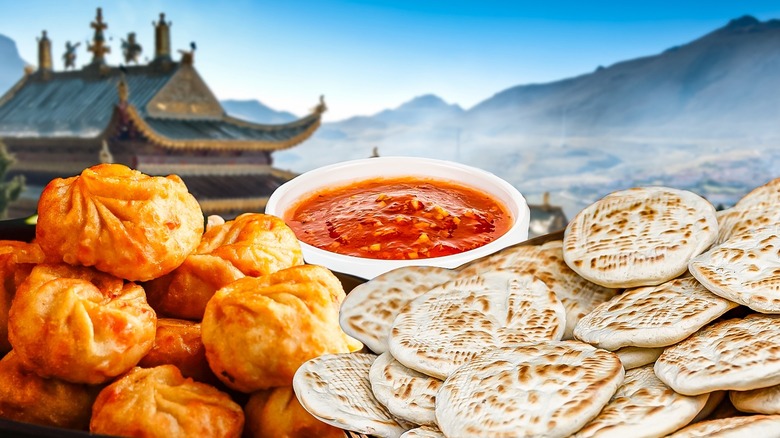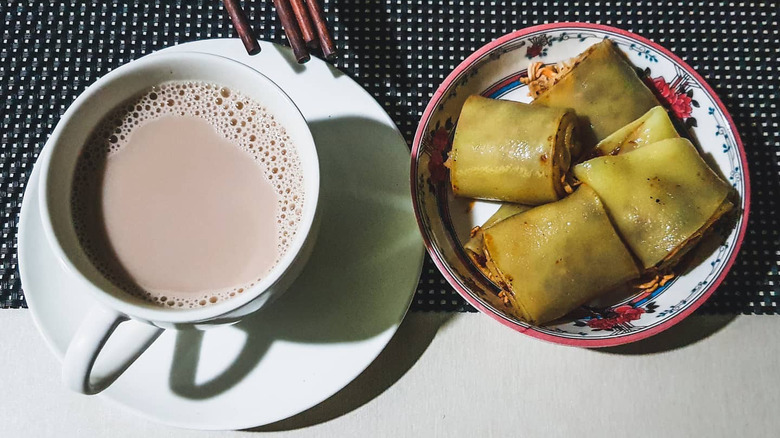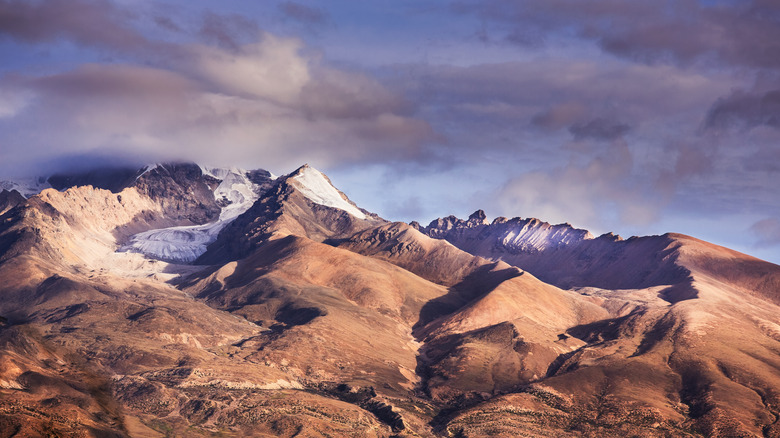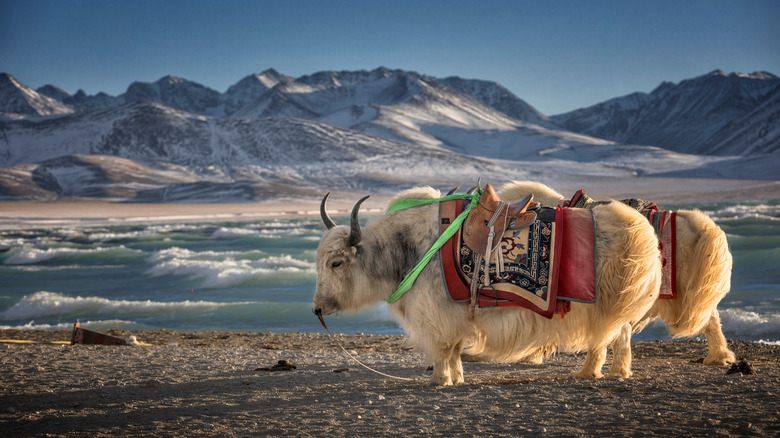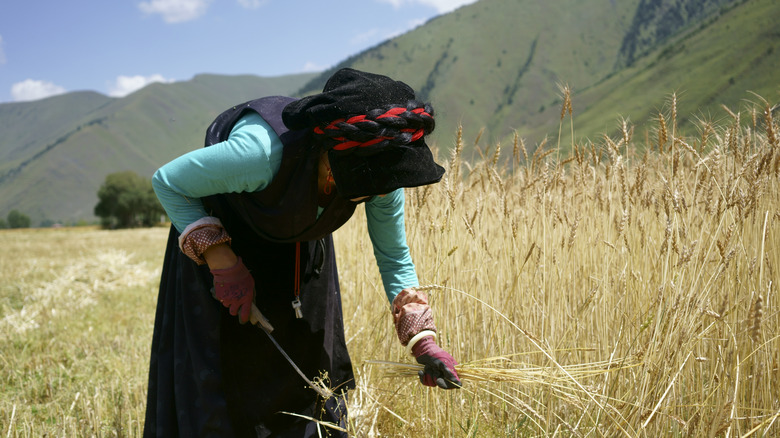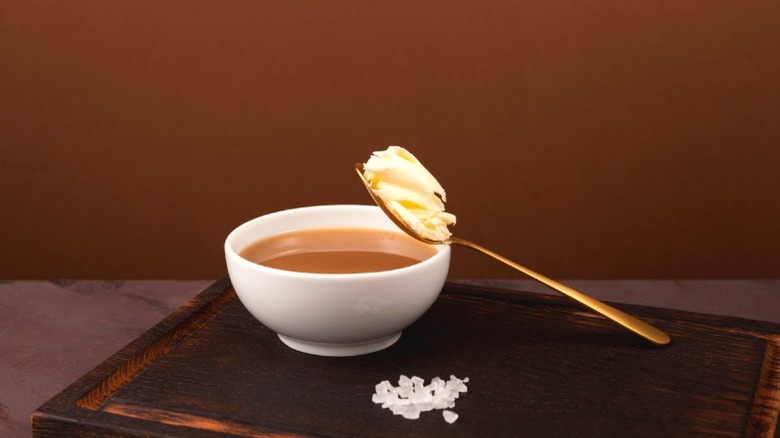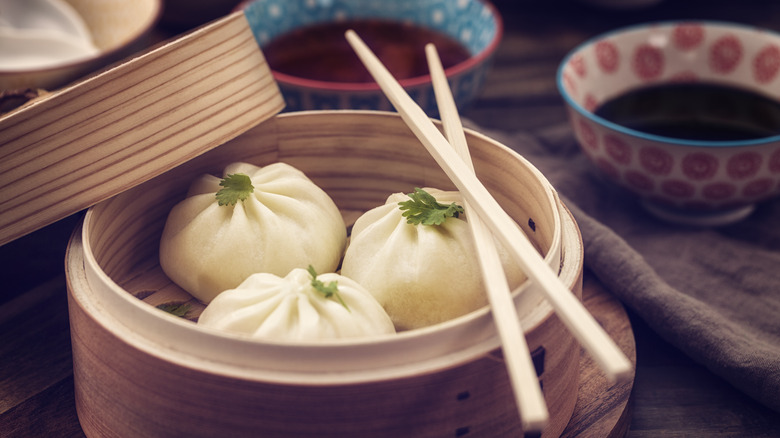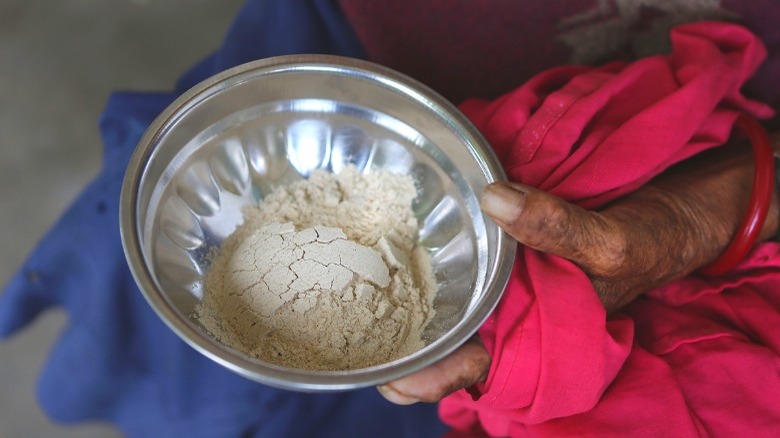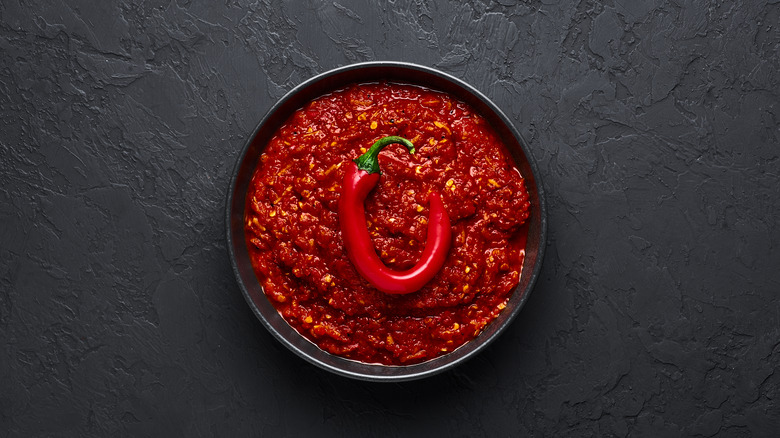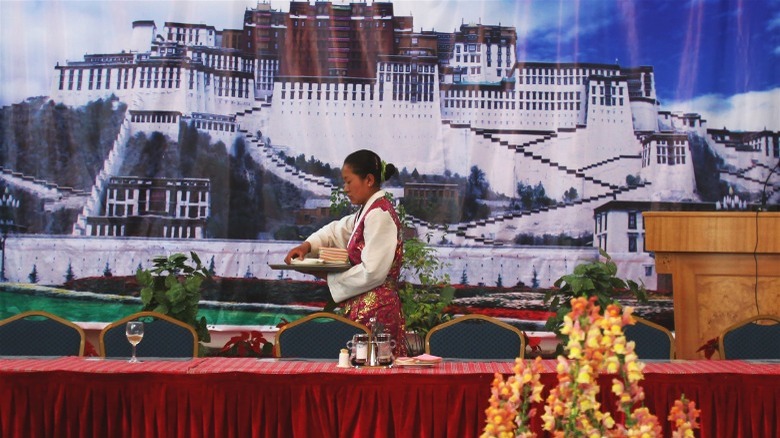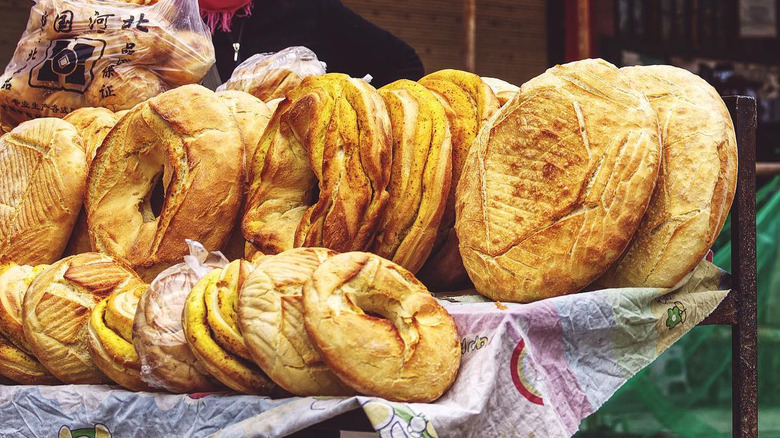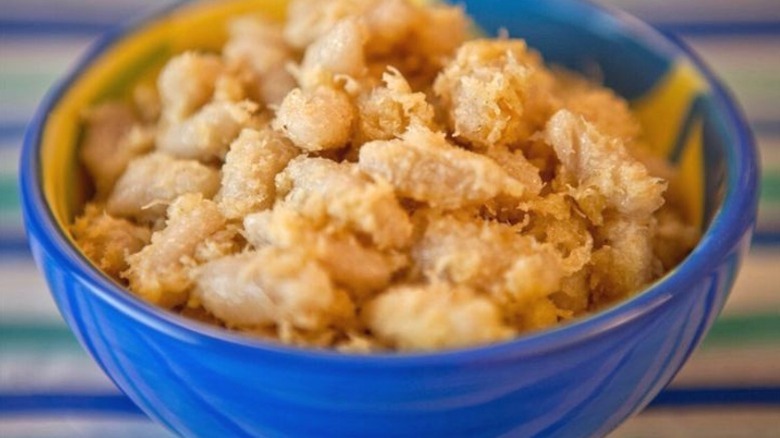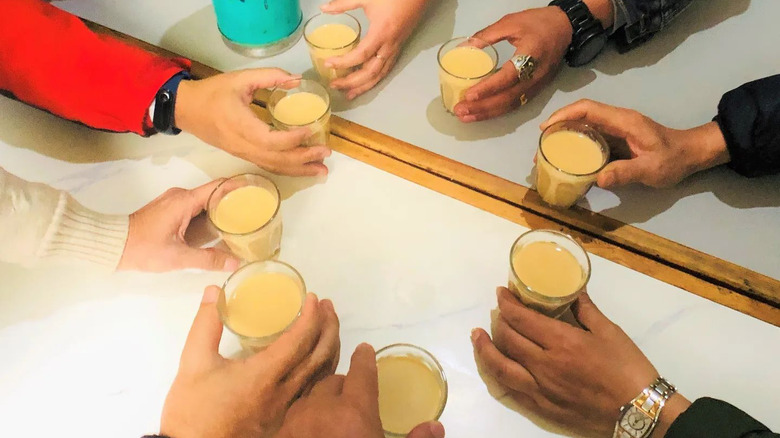The Ultimate Guide To Tibetan Food
Known as "the roof of the world," the Tibetan Plateau sits between China, Nepal (with which it shares Mount Everest), Myanmar, Bhutan, and India at an average elevation of more than 14,000 feet above sea level. Although China has claimed the region since its 1950 invasion, Tibetans consider their land to be an occupied country and continue to celebrate their distinct cultural traditions. One of the areas in which their individuality is most apparent is their cuisine, which tells a story of their rich and varied heritage. According to Kyikyi, a Tibetan refugee and founder of the Portland, Oregon-based food company Himalayan Dumplings, "Tibetan cuisine is a no-fuss cuisine; simple in flavors, wholesome and comforting in taste; reflecting the ancestral nomadic way of life before Tibet was occupied."
Meat, especially yak and beef, plays a key role in the Tibetan diet, as does a type of barley that is only found on the plateau. According to Lobsang Wangdu, a Tibetan chef and co-founder of the travel portal YoWangdu: Experience Tibet, this cuisine is defined by its environment. "[G]enerally speaking," he explains, "Tibetan food reflects what can survive at Tibet's average elevation ... Highland barley is the most important grain, followed by varieties of wheat, while only the hardier vegetables tend to thrive in Tibet." Despite these constraints, Tibetan food is varied, complex, and delicious. It also offers a window into the traditions and heritage of the people who call the region home.
It's distinct from Chinese and Nepalese food
With its connections to China and Nepal, Tibetan food is often conflated with one of the two. But while there are similarities amongst all three cuisines, Tibet has a unique cooking tradition due to the climate and distinct cultures that have shaped it. Like in China, noodle soups and dumplings feature heavily on many Tibetan menus, but other similarities are scarce. Because of its elevation and cool temperature, Tibetans rely on yak meat, milk, and a particular kind of barley that only survives on the Tibetan Plateau. Meanwhile, Chinese cuisine draws on agricultural products from a much larger and more varied territory.
The Nepalese environment is similar to Tibet's, so the food from both regions share certain hallmarks such as warming noodle-based soups and hot tea. Nepal has adopted Tibetan momos so wholeheartedly that, as Kyikyi explains, the famous Tibetan dumplings are often erroneously attributed to Nepal. But despite these similarities, Nepalese food is heavily influenced by its neighbor, India, and therefore tends to have more spices than Tibetan food. Though it is nowhere near as internationally known as Chinese or Nepalese food, Tibetan food is a distinct cuisine full of unique dishes that you won't find anywhere else.
Tibetan cuisine has been shaped by the Himalayan environment
With an average elevation of 14,000 feet above sea level (comparable to the highest peak in the contiguous U.S.), Tibet is not an easy place to cultivate food. Freezing temperatures, harsh sun, heavy winds, dry air, and low oxygen prevent many crops from growing. According to Wandgu, highland barley is the most crucial crop, while vegetables robust enough to withstand the climate include radishes, cabbage, turnips, green peas, carrots, potatoes, mustard, and green onions. Although most Tibetans are Buddhist, few are vegetarian despite it being a widespread practice among followers of the religion. Wangdu suggests this is largely due to the limited diet offered by the Tibetan environment.
The climate also affects Tibetans' nutritional needs. With heavy exposure, temperature variation, and rugged terrain, they turn to high-calorie food such as meat and dairy to keep their energy levels high. Yak, mutton, and beef are common, while highland barley is ground and turned into flour, known as tsampa.
Yaks play a pivotal role in Tibetan culture and cuisine
Yaks have played an integral role in Tibetan society for thousands of years. The large, wooly animals can roam wild on the plateau, while domestic yaks live alongside farmers and nomads, where they are used for everything from trekking to meat. Wangdu believes that they are "inseparable from being Tibetan," and that even for people living in cities who don't own livestock, the animal is a deeply-ingrained part of the collective Tibetan identity.
For nomads who inhabit the harsh northern part of the plateau, where the average temperature is below freezing and the elevation is around 15,000 feet, yaks are an intrinsic part of daily life, providing milk, meat, and fur that is used for making ropes and tents. They also carry supplies and produce dung, which is burned for fuel. Wangdu points out that, contrary to popular belief, there is no such thing as "yak cheese" or "yak butter," since the word "yak" only refers to the male of the species. The females, known as dri, produce dairy.
The animal is so integral to Tibetans that it features heavily in traditional festivals and celebrations. Yak racing is a popular event during these occasions and is treated both as a sport and a celebration.
Highland barley is more than just a grain to the Tibetan people
In a land where few crops are hardy enough to withstand the elements, highland barley is a small miracle. According to archaeologists, Tibetans have been cultivating the grain for more than 3,600 years and credit it with the very existence of their society. Thousands of years ago, nomadic hunter-gatherers roaming the plateau could not settle above a certain elevation due to the lack of food. With its ability to thrive at over 11,000 feet above sea level, highland barley changed the direction of Tibetan life and settlements sprang up in the high region.
These days, the grain is as important as ever. In cooking, it is roasted and ground into flour, called tsampa, which is a staple in the Tibetan diet. It is also used to make barley cake, noodles, and wine. In traditional Tibetan medicine, it is believed to aid ailments such as toothache and neck pain. It holds such an important place that it's used as confetti to shower newlyweds and is offered to the Buddha during celebrations of the Tibetan New Year, known as Losar.
Butter tea helps combat the elements
One of the cornerstones of Tibetan life is butter tea. Combining fermented black tea, salt, and butter from female yaks (dri), it was created by farmers living at high altitudes and is traditionally part of every meal. Just as Tibet's geography varies, so does its butter tea. Depending on where you are, it may be sweet or savory, made with milk or laden with butter. Butter tea is known for its many health benefits. The fat content offers much-needed calories for farmers and nomads, while caffeine from the black tea provides energy. In a place where temperatures hover around 50 degrees Fahrenheit in summer, the heat also provides a welcome respite from the elements.
American entrepreneur Dave Asprey was so astonished by the rejuvenating qualities of butter tea during a trip to Tibet in 2004 that he brought the concept back to the U.S. Bulletproof coffee was his Americanized version of the drink and, after aligning it with weight loss jargon, Asprey struck gold and kicked off a booming niche in the high-fat, low-carb diet sector.
For Tibetans, however, butter tea has a long history rooted in a challenging environment and tenacious people who settled in the region thousands of years ago. Wangdu describes it as "a common denominator in Tibetan culture for centuries if not longer," and says that to this day, it remains an important part of life even for Tibetan people living in the U.S.
You've probably heard of Tibetan dumplings
Perhaps the most famous Tibetan food is momo, the doughy parcels often filled with delicious meat. Momos were reportedly invented in Tibet but have been adopted throughout other Himalayan countries, including Nepal, India, and Bhutan. As Kyikyi explains, momos differ from other types of Asian dumplings in three ways: the wrappers, the filling, and the sauces. The wrappers are dairy- and egg-free, while the filling includes spices like coriander and cumin that are not found in traditional Chinese dumplings. According to Kyikyi, these flavors reflect the journey of Tibetan refugees through India. The dipping sauces are also distinct. Kyikyi favors chili sauce as well as a milder variety made with cilantro.
Momos have become such a popular food outside of Tibet that organizers hold an annual Momo Crawl in New York City where crowds descend to sample momos from more than 30 Tibetan and Nepalese restaurants. The event has been held every year for over a decade and attracts thousands of enthusiastic eaters.
For Kyikyi, momos offer more than just a delicious meal. They also offer an opportunity to share her heritage. She credits her local Portland, Oregon community with turning her small business into an overwhelming success. "For many of my local customers," she says, "[M]y food has become a beautiful gateway to learn more about Tibetan culture and our story directly from the source culture, which is uncommon as our story and narrative is often told through the lens of others."
Tsampa flour is a versatile staple and a cultural symbol
Roasted barley flour, known as tsampa, is such an important food in Tibetan life that it is not unusual to have something made with tsampa at every meal. It is traditionally combined with tea and butter to make a malleable dough. When tsampa is eaten for breakfast, it is often turned into a porridge with hot tea or milk, butter, sugar, and cheese. For dinner, it can be combined with broth and vegetables to make a hearty soup. Some Tibetans even eat tsampa plain, scooping it out of the bowl with their hands. The Dalai Lama is said to eat tsampa for breakfast, preferring his to be mixed with dri milk and tea. Wherever you are in Tibet, chances are good that tsampa will feature at some point in nearly every meal.
Tsampa is more than just a pantry staple, however. For Tibetans, it has been a powerful unifying force in a diverse region that has been fractured by annexation. After China invaded Tibet in 1950, a local newspaper helped unify Tibetans by referring to them as tsampa-eaters. The encouragement led to a revolt against the occupation in 1959. Even though it ended in bloodshed and China continues to lay claim over the territory, many Tibetans still proudly identify as tsampa-eaters.
Do not underestimate the hot sauce
Tibetan food is usually seasoned relatively lightly. Salt, garlic, and onions feature heavily in many dishes, but meals rarely contain the abundance of spices that you would find in Nepalese food, which in turn is generally milder than food from neighboring India. While most Tibetan food is flavored simply, however, the hot sauce from this culinary tradition does not pull its punches. Known as sepen, this sauce is usually made from red hot peppers, tomatoes, onions, celery, garlic, salt, and oil. It varies in consistency, ranging from a paste to a loose, dippable sauce. Either way, it is traditionally seriously spicy, even for those whose palates are accustomed to plenty of heat.
One of the simplest recipes for sepen, found predominantly in the capital city of Lhasa, is made of nothing but water, salt, and chili powder, while tomatoes are a common ingredient for Tibetans who have access to more produce, such as those living abroad.
If you come across it, you'll want to use sepen sparingly to avoid burning your tongue or to dial back the heat in the recipe. It pairs well with a variety of dishes, including momo, tsampa, and flatbread (known as balep korkun).
You're unlikely to find fish on Tibetan menus
Unlike Buddhists in other parts of the world, Tibetans consume meat regularly, especially beef and yak. One type of meat that you won't see in Tibet, however, is fish, despite the abundant supply found in the region's many lakes and rivers. Kyikyi explains that this is rooted in the Tibetan Buddhist philosophy that "all life, no matter the size, is equal." Due to their small size, many fish would have to be killed to make up the same amount of meat that one yak could provide.
Tibetans also refrain from eating fish because of the belief that they are incarnations of the water god. Many Tibetans receive water burials, making bodies of water sacred places that should remain untouched except for peaceful activities. In Buddhism, fish are also one of the eight auspicious signs that make up the astamangala, a group of symbols that represent the divine gifts bestowed upon the Buddha after his enlightenment. While Tibetan food is usually centered around meat, fish is strictly off-limits in most homes and restaurants.
There are many unique types of bread in Tibet
In a climate that demands serious energy and physical stamina, Tibetans have to rely on starchy carbohydrates. In addition to tsampa and momos, this is most apparent in the wide variety of bread and pasta on Tibetan menus. These variations are not only specific to Tibet as a whole but to regions within Tibet as well. The most basic type of bread, balep korkun, is an unleavened flatbread found in central Tibet that requires nothing more than flour and water. Amdo balep is a flatbread found in the northeast that uses yeast, flour, oil, sugar, water, and yogurt. Logo momo and tingmo are steamed breads with a hint of sweetness. Logo momo is molded into rolls that resemble small domes, like mushroom caps, which are pan-fried before being steamed in water or tea. Tingmo is cut into strips and twisted, like a more intricate cinnamon bun, then steamed. When it comes to special occasions, numtrak balep (fried bread) is the favored option. Shaped into discs with three cuts in the middle, it has a distinctive, puffy appearance and is a sign of a celebration.
Noodles are also a staple in Tibetan culture and can often be found in soups with broth, meat, and vegetables. These come in many shapes, from doughy, cashew-shaped bhatsa to machine-made noodles that resemble spaghetti. When paired with warm broth and nutrient-rich vegetables and meat, they are the perfect food for frigid winter months.
Tibetan mac and cheese offers a surprising flavor combination
Tibetan cuisine rarely includes dessert, but Kyikyi points out that there are some dishes with sweet ingredients that are eaten as a main course during particular times of the year. The most prominent example is bhatsa marku, which translates loosely to "buttered dough bits." When Kyikyi explains the dish to non-Tibetans, she says she describes it as sweetened mac and cheese. "We handmake macaroni from scratch," she says, "[T]o which we add Tibetan butter, bits of dry Tibetan cheese that adds a bite to the mouthfeel, and jaggery [a type of unrefined sugarcane] for the sweetness." Cheese from the female yak is difficult to substitute without changing the dish. Since its melting point is high, this cheese retains its solidity when cooked, giving each bite a distinctive texture.
Bhatsa marku is traditionally eaten during the Buddhist festival of Saga Dawa, which honors the birth and enlightenment month of the Buddha Sakyamuni. During this time, Kyikyi explains, many Tibetans practice vegetarianism, making this vegetarian dish a popular meal. Although she says it has lost some popularity with younger people, it's worth trying your own version at home to discover what you've been missing with American-style mac and cheese.
Sweet dishes are part of the Tibetan New Year
As both Kyikyi and Wangdu attest, dessert is not a standard course in Tibetan cuisine. But there are several sweet dishes aside from bhatsa marku that you might find on the table, especially during Losar, the Tibetan New Year. This holiday lasts for 15 days and, as Kyikyi explains, food is a central part of the celebration. Many households start the first day of Losar with a bowl of fermented rice wine porridge and end the day with thukpa, a noodle soup that represents long life and the beginning of the new year. But by that time, the culinary celebrations have already been underway for quite a while.
"Many of the food preparations begin days and sometimes weeks before Losar," Kyikyi says. One of the staple foods made ahead of the holiday is Khapse, "a deep-fried ceremonial Tibetan cookie, sometimes sweetened [and] delicate in design." During the holiday, Tibetans create an altar on which they arrange different types of khapse in a specific order. For example, many cooks shape the first khapse into a scorpion to ward off bad luck. Other popular forms include donkey ears, elaborate braids, and knots.
Another popular sweet food eaten during Losar is dresil, a rice dish cooked in unsalted butter and mixed with raisins, dates, nuts, and a native root vegetable native called droma. Many people eat dresil on the first day of Losar and other ceremonial occasions such as weddings.
Sweet tea is a daily fixture, especially in social settings
Sweet tea is wildly popular in Tibet, though Wangdu points out that it's a much more recent addition to daily life than butter tea. "When I was child," he says, "[W]e hardly had access to sugar, so no one really drank sweet tea." These days, however, he describes the two types of tea as "pretty much interchangeable"
In Lhasa in particular, sweet tea is everywhere, much like coffee in the U.S. It is usually a combination of black tea, milk, and sugar, and is popular as a morning pick-me-up and a social drink in the afternoon. Teahouses are a common gathering place for Tibetans, especially in towns and cities where they are often open from early morning until midnight. Like coffee shops in the U.S. or pubs in the U.K., teahouses are a place for people to relax and spend time together around their favorite drinks. A dice game called xiu is commonly played at these establishments, and food is often served as well, including noodles, tsampa, and momos.
